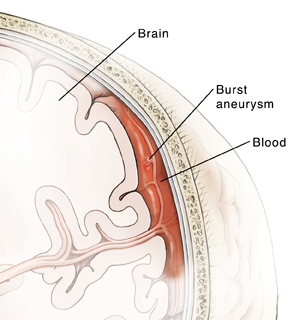Hemorrhagic Stroke: Subarachnoid Hemorrhage
A hemorrhagic stroke happens when a blood vessel in the brain ruptures or leaks. A blood vessel on the surface of the brain bursts and bleeds (hemorrhages). This spills blood into the subarachnoid space around the brain and sometimes into the brain. The arachnoid is one of the 3 membranes that surround the brain. In a subarachnoid hemorrhage, the blood leaks under this membrane and around the brain (in the subarachnoid space).
This type of stroke often happens suddenly, with little warning. It's the most serious of all types of strokes.

What happens during a subarachnoid hemorrhage?
This type of stroke happens when a major blood vessel bursts on the surface of the brain. Normally, the subarachnoid space is filled with a clear fluid, the cerebrospinal fluid (CSF). When the blood vessel bursts, blood flows into the CSF. The amount of fluid in the subarachnoid space increases and puts pressure on the brain. This extra blood and CSF is named hydrocephalus. In addition to flowing around the brain, blood can also enter and damage the brain. Blood in the brain is called a brain hematoma or blood clot.
Most of these strokes happen when a cerebral aneurysm or arteriovenous malformations bursts. An aneurysm is a weak spot in the wall of a blood vessel. A bubble often forms in this weak spot. In some cases, a cerebral aneurysm causes pain or other symptoms. In most cases, though, an aneurysm causes no symptoms until it bursts.
What are the symptoms of a subarachnoid hemorrhage?
Any stroke is a medical emergency. If you have any of these symptoms, even if they seem to get better, call 911 right away:
-
Sudden, excruciating headache with no known cause
-
Nausea and vomiting (often with headache)
-
Sudden confusion or decrease in alertness
-
Trouble moving or loss of feeling, especially on the face, arm, or leg specifically on one side of the body
-
Sudden trouble walking, dizziness, loss of balance or coordination
-
Sudden trouble talking or understanding speech
-
Sudden mood changes
-
Sudden dimness, double vision, or loss of vision, particularly in one eye
-
Eyes suddenly very sensitive to light
-
Neck and shoulder pain or stiff neck
-
Seizure
How is a hemorrhagic stroke treated?
The short-term (acute) phase lasts from the first minutes to hours after symptoms start. During this phase, treatment focuses on easing pressure on the brain and preventing more damage. You may have a procedure or surgery to repair the burst (ruptured) aneurysm. A drain may be placed into the brain to remove CSF and ease pressure to treat the hydrocephalus. This drain can also be used to measure the brain pressure. You may get medicines through an IV line to control blood pressure. You may also get seizure medicine. Tests will likely be done to check for other aneurysms in the brain. If they are found, you may need surgery to reduce the risk that they will burst and bleed. Even if there is no more risk of bleeding, after a subarachnoid hemorrhage people are at risk of a stroke from tightening of the blood vessels (vasospasm) for about 14 days.
After the acute phase, treatment focuses on recovery. Long-term damage from a stroke can include paralysis, trouble speaking or understanding, and trouble thinking clearly. Rehab can help reduce these effects and regain skills. Rehab starts in the hospital and generally continues in an inpatient or outpatient facility, and eventually at home. It will focus on regaining lost skills. It may include:
In addition, medicines that help prevent another stroke may be given. These include medicines to control blood pressure and prevent bleeding.